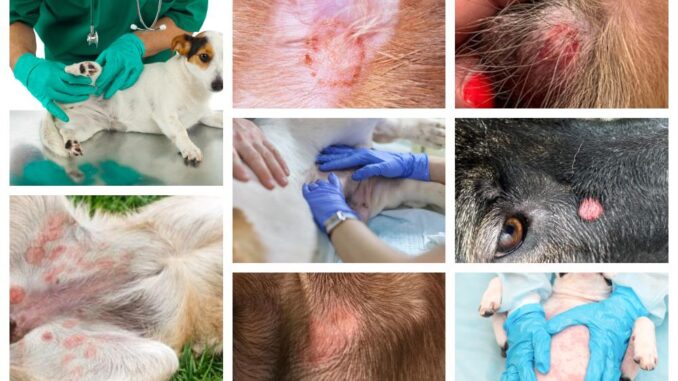
Recently, a client asked me to examine their dog’s red, circular skin spots. After taking samples, I diagnosed the lesions as gnat bites and recommended an itch-relief shampoo to soothe the dog’s skin during bathing.
Gnats, parasites, allergies, and skin infections are common causes of skin issues and red circular lesions in dogs. In this article, I will discuss what you need to know about these issues and how you can best help your dog. Look out for key insights from our veterinarians Dr. Liz Guise & Dr. Linda Simon.
Key highlights:
– Usually, red circular spots are the result of bacterial/fungal infections, allergic reactions, or parasites
– It’s best to isolate dogs that have circular red spots from other pets
– If the spots are localized and symptoms are minor, you may monitor and treat your dog’s condition at home
– Call your vet if the lesions cover a large part of the body or if your dog is showing signs of discomfort or illness.
Top causes of red circular lesions or spots in dogs (with pictures)
1. Ringworm
As shown on the pictures below, ringworm lesions in dogs usually appear as patches of hair loss that are usually crudely circular. They may be red, crusty, or scabby.
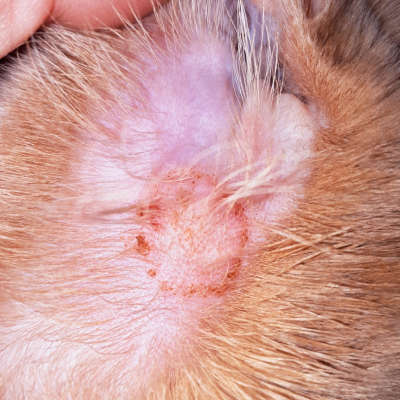
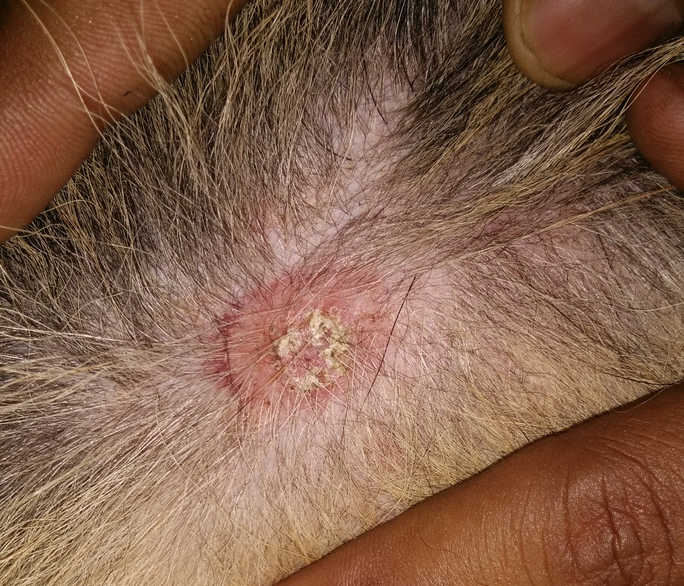
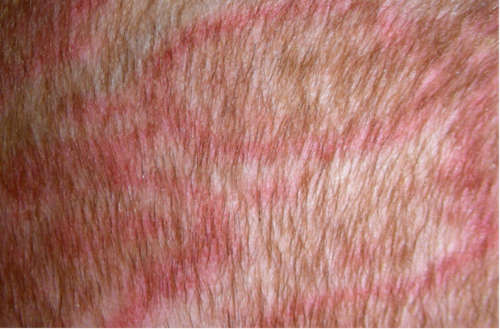
When ringworm affects dogs, the infection sites usually appear on the ears, face, feet, and tail. Occasionally the fungus infects the nail bed and makes the toenails brittle and rough.
Treatment of ringworm: If your veterinarian diagnoses ringworm on your dog, he will recommend a tiered approach to treatment.
At home, you can apply topical antifungal ointments to the lesions and bathe your dog with a medicated shampoo. Finally, clean and sanitize the home to remove fungal spores from the environment.
In addition to topical treatments, your veterinarian will likely prescribe oral antifungal medications. It’s imperative that you follow the doctor’s instructions because ringworm is a stubborn infection. Most dogs recover from ringworm infections, but the symptoms can return if you stop treatment too soon.
Learn more about Ringworm In Dogs: Pictures & Treatments.
2. Bacterial infections
The picture below shows a red, circular lesion that is quite inflamed (staphylococcus bacterial infection). This is sometimes called a ‘bullseye’ lesion. A skin swab or pluck should help reach a diagnosis.
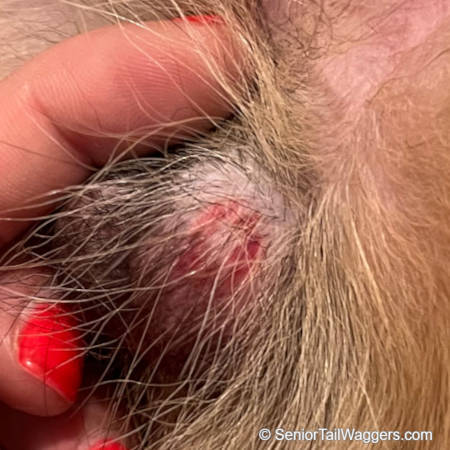
Bacterial skin infections in dogs usually appear as red, raised papules or pustules that resemble pimples. Other common signs include crusty or flaky skin and a white, pus-filled center. Sometimes, the lesions will ooze pus or serum.
Treatment of bacterial infections: If your dog’s infection is localized and the symptoms are minor, you may be able to treat your dog at home after your check with your veterinarian. Some at-home remedies that may be able to help your furbaby recover include:
- medicated shampoos,
- over-the-counter ointments, and
- natural anti-itch remedies such as an oatmeal bath.
Dogs with more severe symptoms or widespread lesions will need veterinary treatment. In these cases, veterinarians may take a skin swab to culture the bacteria and prescribe appropriate antibiotics. Most skin infections resolve in 3-4 weeks with treatment (some resistant bacterial strains may require 2-3 months or more).
Learn more about Bacterial Skin Infections.
3. Insect bites
The red circular lesions on this dog’s belly, are a result of gnat bites:
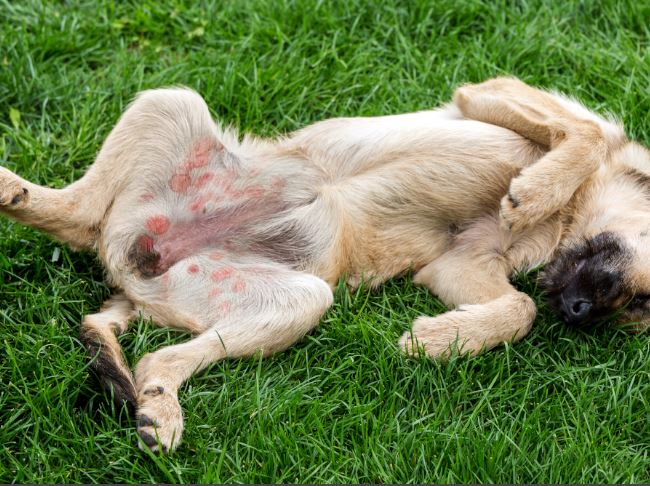
Initially, gnat bites can resemble ringworm or Staphylococcus skin infections. Typical symptoms include red ring-like lesions that look roughly like a bullseye, slight crusting, and mild itchiness. If your dog suffers from gnat bites, you’ll usually observe clusters of red spots in furless areas such as the belly and inner hind legs.
Treatment: Fortunately, gnat bites usually cause minor irritation and itching in dogs. To help soothe your furbaby’s discomfort, you can use an oatmeal bath, anti-itch shampoo, or salt water. The symptoms should resolve in a few days.
Occasionally, dogs will develop secondary infections from gnat bites. If your pooch’s lesions are oozing, spreading, or have a bad odor, contact your veterinarian to schedule an exam.
Although rare, some dogs will have severe allergic reactions to gnat bites. If you notice difficulty breathing, hives, or facial swelling take your dog to the emergency clinic immediately.
Learn more about Gnat Bites or Insect Bites.
4. Injuries (scratches or bites)
The dog in the picture below has a crusted, circular lesion on the chin, which has recently been bleeding.
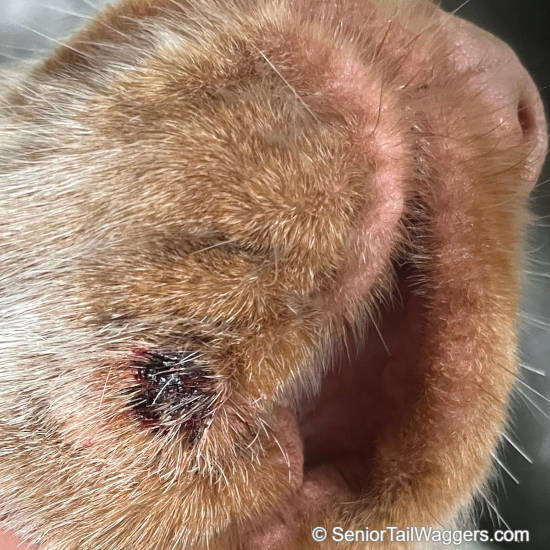
For most young dogs, this type of lesion will just be a healing cut, perhaps caused by a rogue scratch or an insect bite. Less commonly, it can be the result of a foreign body under the skin (like a grass awn), a ruptured cyst, or a primary skin infection.
Treatment: Simple injuries can be managed at home by gently cleaning the wound and applying an antibacterial ointment. Talk to your veterinarian before applying home remedies. If your dog continues to lick or scratch the wound, use an e-collar to prevent further trauma.
Learn more about the Stages of Wound Healing.
5. Warts or histiocytomas
The picture below shows a dog with a small, round, and furless raised lesion that is mildly inflamed. It could be a wart (papilloma) or histiocytoma (benign lesions that grow in young dogs).
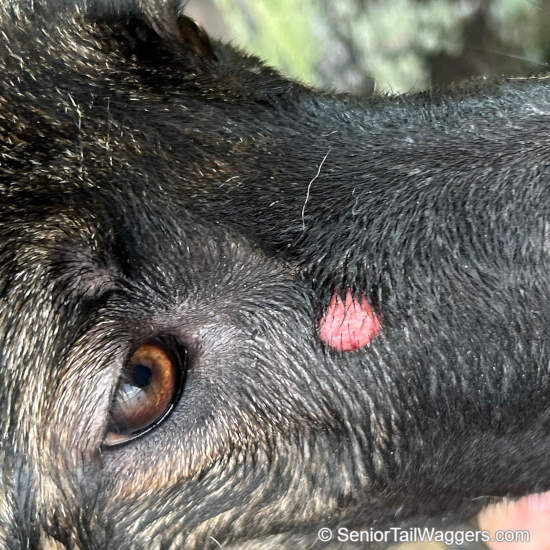
Warts, also known as papillomas, and histiocytomas are usually benign lesions that can occur singly or in clusters on your dog. Warts are generally caused by the papillomavirus, and histiocytomas are caused by an overgrowth of immune cells known as histiocytes. Both appear as raised, red or pink, circular lesions. They can be solitary or occur in clusters.
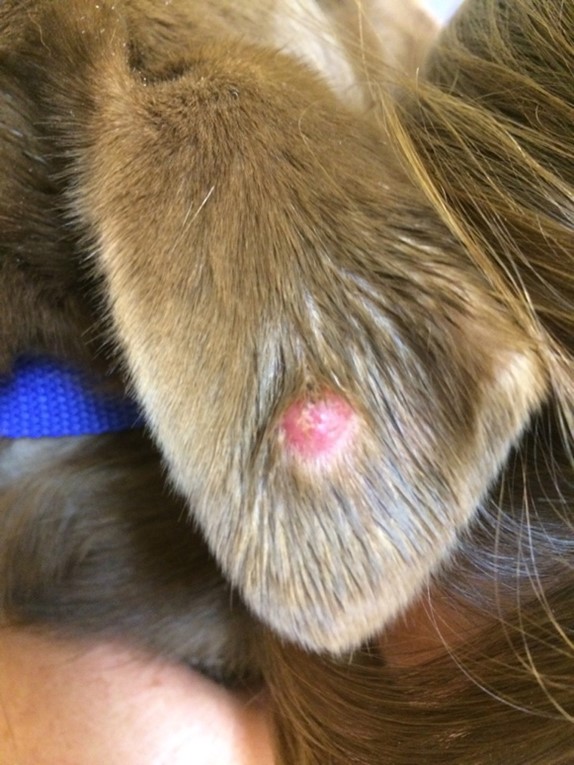
Photo: Ian Brett Spiegel VMD, MHS, DACVD
Histiocytomas usually resolve naturally in about 1-3 months. If they get worse, contact your veterinarian. Warts usually do not require treatment and tend to resolve as your dog builds immunity. If they become infected or make your dog uncomfortable, they can be surgically removed.
Once you visit your vet, you can usually monitor warts or histiocytomas at home. Keep the area clean and dry by washing it with mild, dog-safe cleansers. Try applying some vitamin E oil to warts to help promote healing. For histiocytomas, flush the lesion with a mild saline solution.
Learn more about Histiocytomas (Pictures & Vet Advice).
6. Parasites
The picture below shows a few flat skin lesions that are bright red and circular. They are likely a result of bug bites or external parasites.
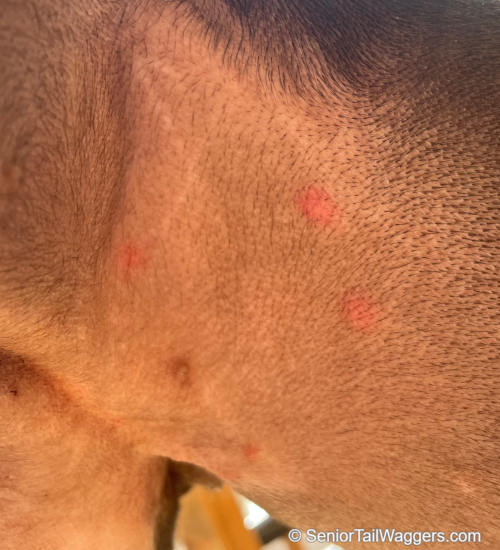
However, veterinary tests are required to confirm the diagnosis: the lesions could also be a fungal infection (such as ringworm), a bacterial skin infection, or an allergy.
Bites from external parasites frequently cause skin reactions and irritation. On rare occasions, dogs will have severe allergic responses with anaphylactic shock when parasites bite them. If your furbaby shows signs like respiratory distress, facial swelling, or hives, take him to the emergency clinic ASAP.
Parasite bite reaction signs usually include raised red bumps, light crusting, hair loss, and itching.
If your dog has raised red lumps that resemble reactions to parasites like fleas, ticks, or lice, and you don’t see any pests, talk to your veterinarian. He should be able to diagnose the condition by observing the signs and running appropriate diagnostic tests.
Treatment: Once you know what type of insect or parasite bit your dog, you can treat him to eliminate the bugs. The lesions should resolve once the parasites are gone. If your pup’s skin lesions are inflamed and itchy, use an oatmeal bath to soothe his skin.
7. Local allergic reactions
This dog has a small patch of skin that is red and sore looking, with very mild crusting, as a result of a local reaction – most likely from a plant or an insect sting:
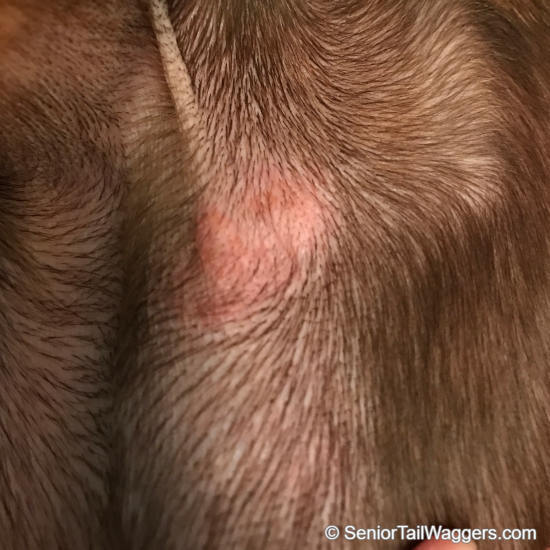
Local reactions to flying insects like mosquitoes appear as red, itchy skin lesions. The localized allergic reaction may be raised and look like a welt. As long as your dog doesn’t have an anaphylactic reaction (described in the section above), you can try a few home remedies to relieve pain and itching. Always talk with your vet first.
If your dog was bitten by a bee or wasp, look for the stinger and remove it with tweezers or your fingers. Next, you can apply a cool compress to the area to reduce swelling. If the inflammation and itching are pronounced, talk to your veterinarian about giving your dog a dose of Benadryl. You can also apply some aloe vera gel or a baking soda and water paste to help promote healing.
Learn more about Allergies & Skin Reactions.
When it is ok to monitor the situation at home
It is most likely ok to monitor your dog at home if:
– the lesions are localized and the symptoms are mild
– your dog appears otherwise normal (no signs of discomfort or illness)
– your veterinarian advises you to monitor your dog at home
Some ways to help your dog at home and speed healing include bathing with a medicated anti-itch shampoo, applying topical ointments to treat surface skin infections or inflammation, and giving your dog an antihistamine to treat local allergic reactions. Be sure to check with your vet before starting any home treatment. Of course, the right treatment depends on the cause of these new circular red lesions.
When you should call your vet
- you observe signs of anaphylaxis (respiratory distress, facial swelling, or hives) – take your dog to the emergency clinic immediately
- the lesions on your dog are extensive and cover a large part of the body
- your dog has bleeding or oozing skin
- your dog is depressed or won’t eat
- your dog has other signs of illness like vomiting or a fever
- your dog is not comfortable (for example, when the lesions are itchy)
How can you figure out what these circular red spots are?
Because many conditions that cause red circular spots share similar symptoms, you’ll need to take your dog to the veterinarian for a diagnosis. The initial office visit and exam usually cost about $50-150.
Diagnostic tests:
Based on your dog’s history, clinical signs, and symptoms, your doctor can diagnose some conditions Other times, he’ll need to run additional tests, including:
- skin scraping or hair plucks and examination under a microscope for certain skin parasites and ringworm (cost about $50-100)
- wood lamp examination for ringworm (often included in the office exam)
- skin culture for fungus or bacteria (cost about $50-100)
- skin biopsy and cytology for histiocytomas or warts (cost about $100-200)
Example: In the picture below, you can see a lesion on the head that is oval-shaped and has lost fur. The skin surface is broken. This could be ringworm, but could also be a recent insect sting, a small cyst, or a bacterial infection. A fur pluck or skin swab is needed to confirm a diagnosis.
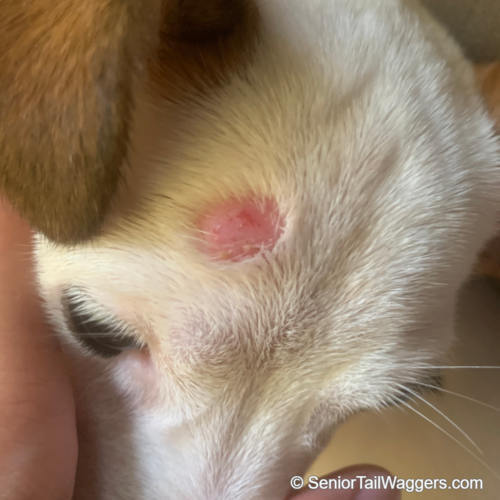
Disclaimer: This website's content is not a substitute for veterinary care. Always consult with your veterinarian for healthcare decisions. Read More.



Be the first to comment